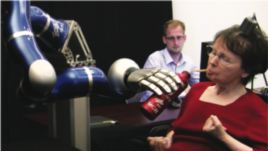分享到

This is the VOA Special English Technology Report.
Cathy Hutchinson is a tetraplegic. She has not been able to move her arms, legs or speak since suffering a stroke nearly 15 years ago. Recently, she learned how to control a robotic arm using her thoughts. She now can use brain activity to serve herself a drink.
The American woman is one of two people who took part in a research project known as BrainGate2. The researchers have spent years studying how to help people who are paralyzed regain movement in their arms and legs.
John Donoghue is a neuroscientist with Brown University and the Department of Veterans Affairs. He also was part of the project.
JOHN DONOGHUE: "People who are paralyzed have their brain disconnected from their body. So they are not able to go out and do everyday things that you and I can do, like reach for a glass of water or scratch your nose. So our idea is to bypass that damaged nervous system and go directly from the brain to the outside world so the brain signals can, not control muscle, but control machines or devices like a computer or a robotic limb."
The two paralyzed people had small sensors connected to the part of the brain that controls movement. The devices measured brain activity and sent that information to a computer.
The computer has special software that turns the information into digital commands for operating other devices. The researchers used a highly developed robotic arm to recreate human actions.
Scientists from Massachusetts General Hospital, Harvard Medical School and the German Aerospace Center also took part in the study.
The BrainGate team had its first success in 2006. A tetraplegic stabbing victim was able use the brain-computer interface system to control a computer cursor. John Donoghue says the latest development using robotic arms is a major victory.
A video of the latest experiment shows Cathy Hutchinson using the robotic arm to pick up a cup of coffee. She guides the cup toward her mouth, moves it forward and drinks through a straw.
Lead investigator Leigh Hochberg says the first time she did it was a magical moment.
LEIGH HOCHBERG: "To see her with that robotic arm reach out and pick up that cup of coffee and serve herself that coffee for the first time in nearly 15 years, it was an incredible moment."
The research team carried out almost 200 tests with two different robotic arms. The two individuals were able to pick up their target objects 43 to 66 percent of the time.
The researchers are calling the information very promising. But they say it will take years to fully develop the technology for everyday use.
A report on the BrainGate study appeared last week in the scientific journal Nature.
And that's the VOA Special English Technology Report. I'm June Simms.
tetraplegic: 四肢癱瘓者
(來源:VOA 編輯:旭燕)
分享到
關注和訂閱


電話:8610-84883645
傳真:8610-84883500
Email: languagetips@chinadaily.com.cn